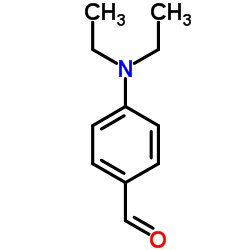4-Diethylaminobenzaldehyde

4-Diethylaminobenzaldehyde structure
|
Common Name | 4-Diethylaminobenzaldehyde | ||
|---|---|---|---|---|
| CAS Number | 120-21-8 | Molecular Weight | 177.243 | |
| Density | 1.0±0.1 g/cm3 | Boiling Point | 329.6±0.0 °C at 760 mmHg | |
| Molecular Formula | C11H15NO | Melting Point | 37-41 °C(lit.) | |
| MSDS | Chinese USA | Flash Point | 110.2±12.0 °C | |
| Symbol |

GHS07 |
Signal Word | Warning | |
|
Formation of spherical cancer stem-like cell colonies with resistance to chemotherapy drugs in the human malignant fibrous histiocytoma NMFH-1 cell line.
Oncol. Lett. 10 , 3323-3331, (2016) Various human cancers have been revealed to contain cancer stem-like cells (CSCs) and the spherical colonies that possess stem-like properties and cancer-initiating abilities. Malignant fibrous histiocytoma (MFH) is a common soft-tissue sarcoma, and is consid... |
|
|
Effective Two-Photon Excited Photodynamic Therapy of Xenograft Tumors Sensitized by Water-Soluble Bis(arylidene)cycloalkanone Photosensitizers.
J. Med. Chem. 58 , 7949-58, (2015) A series of bis(arylidene)cycloalkanone photosensitizers modified by polyethylene glycol (PEG) have been studied for two-photon excited photodynamic therapy (2PE-PDT). As compared with their prototype compounds, these PEGylated photosensitizers show enhanced ... |
|
|
The transcriptional coactivator Taz regulates proximodistal patterning of the pronephric tubule in zebrafish.
Mech. Dev. 138 Pt 3 , 328-35, (2015) The zebrafish pronephric tubule consists of proximal and distal segments and a collecting duct. The proximal segment is subdivided into the neck, proximal convoluted tubule (PCT) and proximal straight tubule (PST) segments. The distal segment consists of the ... |
|
|
Retinoid signaling is necessary for, and promotes long-term memory formation following operant conditioning.
Neurobiol. Learn. Mem. 114 , 127-40, (2014) Retinoic acid, a metabolite of vitamin A, is proposed to play an important role in vertebrate learning and memory, as well as hippocampal-dependent synaptic plasticity. However, it has not yet been determined whether retinoic acid plays a similar role in lear... |
|
|
Development and validation of an LC-MS/MS method for pharmacokinetic study of methoxyamine in phase I clinical trial.
J. Chromatogr. B. Analyt. Technol. Biomed. Life Sci. 901 , 25-33, (2012) Methoxyamine (MX) is the first DNA base-excision-repair (BER) inhibitor evaluated in humans. This work described the development and validation of an LC-MS/MS method for quantitative determination of MX in human plasma. In this method, MX and its stable isoto... |
|
|
Retinoic acid derived from the fetal ovary initiates meiosis in mouse germ cells.
J. Cell Physiol. 228(3) , 627-39, (2013) Meiotic initiation of germ cells at 13.5 dpc (days post-coitus) indicates female sex determination in mice. Recent studies reveal that mesonephroi-derived retinoic acid (RA) is the key signal for induction of meiosis. However, whether the mesonephroi is dispe... |
|
|
Inhibition of mouse cytosolic aldehyde dehydrogenase by 4-(diethylamino)benzaldehyde.
Biochem. Pharmacol. 37(8) , 1639-42, (1988)
|
|
|
4-(N,N-diethylamino) benzaldehyde thiosemicarbazone in the spectrophotometric determination of palladium.
Ann. Chim. 97(10) , 1097-106, (2007) 4-(N,N-diethylamino)benzaldehyde thiosemicarbazone(DEABT) is proposed as a sensitive and selective analytical reagent for the spectrophotometric determination of palladium(II). The reagent reacts with palladium (II) in a potassium hydrogen phthalate-hydrochlo... |
|
|
Retionic acid and its receptors are required for expression of aryl hydrocarbon receptor mRNA and embryonic development of blood vessel and bone in the medaka fish, Oryzias latipes.
Zoolog. Sci. 21(5) , 541-51, (2004) Retinoic acid (RA), the active derivative of vitamin A, is essential for normal embryonic development of vertebrates because both the lack and excess of RA result in developmental malformations. We previously reported that aryl hydrocarbon receptor (AHR) is a... |
|
|
Development and validation of an HPLC-UV method for the analysis of methoxyamine using 4-(diethylamino)benzaldehyde as a derivatizing agent.
J. Pharm. Biomed. Anal. 39(3-4) , 724-9, (2005) Methoxyamine (MX) is a potential new anti-cancer drug. In this paper, a quantitative HPLC-UV method for MX using 4-(diethylamino)benzaldehyde (DEAB) as a derivatizing agent has been developed and validated. The studies showed that MX reacts with DEAB under ac... |